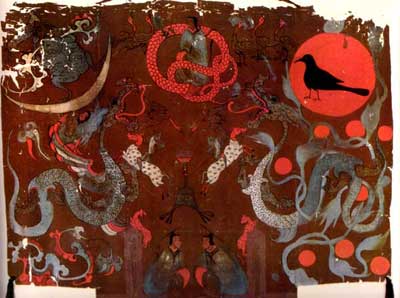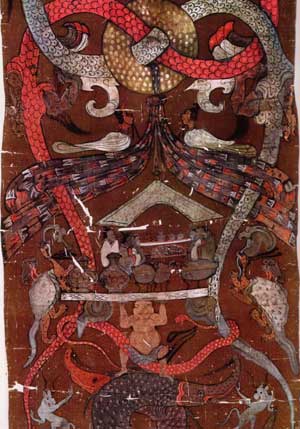Mawangdui
Mawangdui (Chinese马王堆/马王堆, Pinyin Mǎwángduī ) is a 1972 in the former town Dongtundu (东 屯 渡 乡/东 屯 渡 乡) the eastern outskirts Changshas discovered archeological site. The site is now part of road district Mawangdui (Chinese马王堆 街道/马王堆 街道) of the district Furong (芙蓉 区/芙蓉 区) in the east of the prefecture-level city of Changsha in Hunan province of China.
In the Han tombs at Mawangdui (Chinese马王堆 汉墓, Pinyin Mǎwángduī Hànmù ) is a tomb dating back to the early Western Han Dynasty. From 1972 to 1974, the graves were successively excavated from Hunan Provincial Museum jointly with the Archaeological Research Institute of the Chinese Academy of Sciences, two digs. Most artifacts from Mawangdui are exhibited in Hunan Provincial Museum.
From the excavated from grave No. 2 seals " Seal of the Marquis of Dai " (軑 侯 之 印, Dài HOU Zhi Yin), " Chancellor of Changsha " (长沙 丞相/长沙 丞相, Changsha Chengxiang ) and "Li Cang " (利 苍/ 利 苍, Lì Cang ), as well as from many in the tombs No. 1 and No. 3 with the word " overseer of the household of the Marquis of Dai " (軑 侯家丞/轪 侯家丞, Dài Hou Jiacheng ) with cement -sealed grave goods can be seen that it is the tomb of the " Marquis of Dai " (利 苍, Li Cang ) and his family members.
Of the three graves, the grave No one is in scope greatest, the grave chamber was constructed with thick wooden boards from whole pieces, in the middle of the decorated splendid four-layered coffin was placed in the side chamber surrounding it are different types of grave goods. The space outside the grave chamber was filled completely with a large amount of charcoal and white clay. Damage caused by the deep location of the grave chamber and the hermetic sealing, constant temperature, constant humidity, lack of oxygen and aseptic conditions is extremely well preserved the grave. Such a good state of storage as in the excavated female corpse is rarely found in the relevant historical materials (see also Marquess of Dai and the rotated at necropsy short film ).
The structures of grave 3 and grave No. 1 are similar, but their extent is relatively small, the coffins have three layers. The storage situation in grave No. 3 is relatively poor, of the male body is only the skeleton left.
Many silk books were excavated from grave No. 3, including the Book of Changes ( Yijing ), Lǎozǐ ( also Daodejing called, the legendary founder of Daoism ascribed book), as well as books on astronomy, the appreciation of horses according to their appearance ( xiàngmǎ ) and medicine, more than twenty texts with a total of more than 120000 characters. There are also three maps below. The excavated from the two graves colored silk paintings, silk goods, musical instruments, lacquer ware and the data written on bamboo slips so-called " inventory book " (遣 策, qiǎncè ) in which the name and quantity of grave goods are recorded in detail, it is all to important archaeological finds.
In the relatively small extent from grave No. 2, the preservation was very poor. Because the seal was not good and other reasons are not many grave goods received.
All three tombs belong to the second half of the second century BC. The owner of the second tomb, Li Cang (利 苍), died in -186, the third tomb was buried in the year -168, the first grave is later in time than the third.
Excavations of the Han Tombs of Mawangdui provide numerous realities for research into the history of the early stages of the Western Han Dynasty and the analysis of the level of development of that craft production and science technology and the art of their culture and their customs and traditions.
Texts
- Changshaguo nanbu dixingtu长沙 国 南部 地形 图/长沙 国 南部 地形 图
- Cheng ( Huangdi Sijing )
- Chengyitu城邑 图/城邑 图
- Chunqiu Shiyu春秋 事 语/春秋 事 语
- Chuxingzhan出行 占
- Daoyintu导引 图/导引 图
- Daoyuan道 原( Huangdi Sijing )
- Desheng德 圣/德 圣
- Dixingtu
- Ersan zi wen二三 子 问/二三 子 问
- Fu-Lu符 箓/符 箓
- He yinyang
- Huangdi shu黄帝 书/黄帝 书
- Huangdi Sijing黄帝 四 经/黄帝 四 经
- Jingfa经 法/经 法
- Jiuzhu九 主
- Laozi (A)老子
- Laozi (B )老子
- Lishu yinyang wuxing隶书 阴阳 五行/隶书 阴阳 五行
- Liushisi gua六十 四 卦
- Maifa脉 法/脉 法
- Miaohe
- Mingjun明君
- Murenzhan木人 占
- Que gu shi qi却 谷 食 气/却 谷 食 气
- Sangfutu丧服 图/丧服 图
- Shentu神 图/神 图
- Shiliujing ( Huangdi Sijing )
- Shidajing ( Huangdi Sijing )
- Shiwen
- Taichanshu胎 产 图/胎 产 图
- Tianwen Qixiang zazhan天文 气象 杂 占/天文 气象 杂 占
- Tianxia Zhidao tan天下 至道 谈/天下 至道 谈
- Wushi'er bingfang五十 二 病 方
- Wuxing五行
- Wuxing zhan五星 占
- Xiang ma jing相 马 经/相 马 经
- Xici系辞
- Xingde (A)刑 德
- Xingde (B )刑 德
- Xingde (C )刑 德
- Yang Sheng Fang养生 方/养生 方
- Yangshengtu养生 图
- Yao要
- Yijing xiCi易经 系辞
- Yinyang mai sihou阴阳 脉 死 候/阴阳 脉 死 候
- Yinyang Shiyi Maijiu jing (A)阴阳 十一 脉 灸 经/阴阳 十一 脉 灸 经
- Yinyang Shiyi Maijiu jing (B )阴阳 十一 脉 灸 经/阴阳 十一 脉 灸 经
- Yi zhi yi
- Yuanqintu园 寝 图/园 寝 图
- Zajinfang
- Zaliaofang杂 疗 方/杂 疗 方
- Zhanguo zonghengjia shu战国 纵横 家书/战国 纵横 家书
- Zhaoli
- Zhouyi周易
- Zhouyi xiCi周易 系辞
- Zhuanshu yinyang wuxing篆书 阴阳 五行/篆书 阴阳 五行
- Zhuchengtu筑城 图/筑城 图
- Zhujuntu驻军 图/驻军 图
- Zubi Shiyi Maijiu jing足 臂 十一 脉 灸 经/足 臂 十一 脉 灸 经




.jpg)





